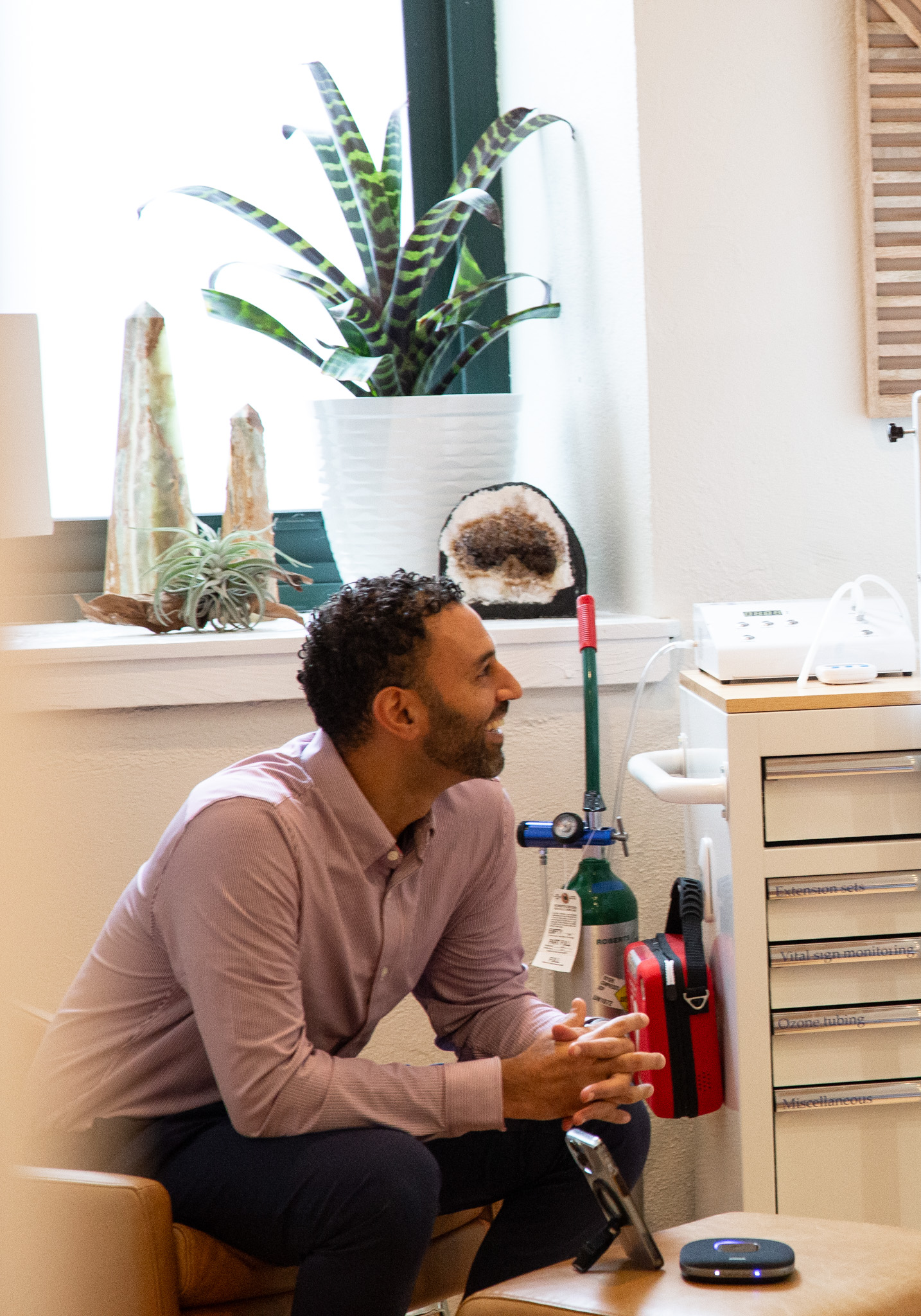
Regenerative Medicine in Philadelphia
At Meeting Point Health, we offer a comprehensive selection of functional and regenerative treatments designed to meet a variety of health and performance needs.

TABLE OF CONTENTS

Repair, Restore, Renew
Regenerative medicine offers a powerful, natural alternative to steroids, pain medications, and surgery by working with your body to promote true healing. While aging and injuries can lead to degeneration, your body’s innate ability to regenerate and repair tissue remains a cornerstone of regenerative medicine. By using advanced therapies like targeted injections or infusions with agents that stimulate tissue repair, we help activate your body’s natural healing processes.
At Meeting Point Health in Philadelphia, Dr. Stephen Matta offers groundbreaking regenerative orthopedic treatments designed to relieve pain, restore movement, and help you avoid surgery. Using state-of-the-art therapies like PRP and stem cell treatments, Dr. Matta targets the root cause of your pain for long-lasting results. Don’t settle for temporary fixes—experience a personalized, proven approach to healing. Your path to pain-free living starts here.
How does regenerative medicine work?
Regenerative Medicine REGROWS tissue. Remember that our bodies use inflammation to clean up damaged tissue and heal but sometimes inflammation goes rogue. The injectable agents we use such as dextrose, ozone, procaine, peptides, vitamins, and biologics can stimulate the body’s own healing processes. While creating pain relief immediately, the treatment effect builds as the body goes to work recruiting its own stem cells to regenerate the area. The full effect builds at around 1-3 months.
At Meeting Point Health, we also use any combination of topical numbing agents, nerve blocks, lidocaine, and Pronox to make your procedure comfortable and relaxing.
Regenerative Medicine Treatment Options
Prolotherapy is an injectable technique used to promote the body’s own healing mechanism with proliferative agents such as dextrose. It is used especially in joint laxity or tears. Where steroids stop the body’s inflammatory mechanism, Prolotherapy injections do the exact opposite by utilizing that inflammatory mechanism to trigger regrowth of collagen in an otherwise degenerating joint. An non-surgical option for many ligament tears and chronic pain due to weakness in the joint.
PRP, or platelet-rich plasma is a treatment that uses the patient’s own blood to stimulate tissue regeneration. This treatment is done by first drawing blood from the patient, and then centrifuging a layer of rich plasma from that sample. This PRP can be injected into areas of pain or degeneration. We will often prescribe PRP after Prolozone and Acupuncture has been used to clean up inflammation and prime the musculature and nerves surrounding the joint.
Stem cell injection therapy refers to a medical procedure in which stem cells are harvested from live, healthy birth tissue and then injected into a localized area on a patient’s body, typically to promote tissue repair, and regeneration, or to treat various medical conditions. Stem cells are unique because they can develop into different types of cells in the body, and they also have the capacity for self-renewal.
Prolozone therapy is a mixture of ozone gas and a prolotherapy solution is injected into the affected area, often around joints, ligaments, or tendons. The theory is that this combination not only irritates and strengthens the tissues (like prolotherapy) but also delivers the potential therapeutic benefits of ozone, such as improved circulation and tissue oxygenation. Prolozone combines procaine, dextrose, B vitamins, saline, oxygen, and ozone into a damaged joint and the combination allows for regrowth of damaged tissue.
Peptides are the building blocks of proteins. Your body naturally makes them and are used in a wide range of biological functions. Peptides are responsible for managing metabolic activity, DNA replication, cell signaling, and other important functions. This newly emerging science is the future of healthcare. Peptides can be applied in the treatment of injuries in our office for joint injections, or at home via subcutaneous injections between sessions.
Nerve entrapments or impingements are quite common in pain conditions, even in very athletic strong patients. They are often mistaken for a problem in the muscle, ligament, or joint. A perineural hydrodissection (aka nerve hydrodissection) procedure involves ultrasound-guided injections of an aqueous regenerative solution such as D5W, PRP or PPP (platelet rich or platelet poor plasma) biologics, Prolozone, vitamins, or peptides to create space around an entrapped nerve. This reduces pain immediately and allows the nerve space to heal. Nerve Hydrodissection is effective for carpal tunnel syndrome, ulnar nerve entrapments, sciatica, and brachial plexus disorders such as thoracic outlet syndrome.
Neural Therapy is a very gentle injection technique aimed at the superficial nerve endings near the surface of the skin. In aiming the injectable (which is usually Procaine) into this space, the nerve endings are programmed. Procaine is a sage anesthetic and can reset the action potential of your nerves as they calm the nerve endings. Neural therapy is extremely effective in highly sensitive pain conditions where even light touch or temperature changes cause intense pain. Neural therapy can also break down scar tissue, such as in C-section scars and other surgical scars.
Soul-Centered Healthcare As a Catalyst For Change
Many people suffer with undiagnosed or misdiagnosed conditions and simply don’t know what’s wrong with them or what will help. We understand what it’s like to feel trapped in a body that is not working for you! At Meeting Point Health, we find the root cause and use a proven, integrative approach that gets results. As highly trained pioneers in functional and regenerative medicine, we’ve helped thousands of patients take control of their health.
OUR PATIENTS FIND RELIEF HERE
Our Patients Find Relief Here
EXCELLENT
We’re here to answer all of your questions
Schedule a call with one of our onboarding specialists today so they can answer all of your questions.
How does Regenerative Medicine work for chronic back pain?
Regenerative medicine uses the body’s natural healing capabilities to repair damaged tissues, reduce inflammation, and restore function. At Meeting Point Health, we offer therapies such as PRP and stem cell injections that target the root causes of chronic back pain.
What is regenerative medicine used for?
Regenerative medicine is highly effective for treating a wide range of conditions, including:
- Joint Pain and Arthritis: Helps reduce pain, inflammation, and stiffness associated with osteoarthritis and rheumatoid arthritis by promoting cartilage repair.
- Tendon and Ligament Injuries: Supports healing of rotator cuff tears, Achilles tendonitis, tennis elbow, and other soft tissue injuries.
- Back and Neck Pain: Treats conditions like herniated discs, sciatica, and sacroiliac (SI) joint dysfunction by regenerating damaged tissues and reducing inflammation.
- Sports Injuries: Accelerates recovery from sprains, strains, and overuse injuries such as runner’s knee or plantar fasciitis.
- Neuropathy and Nerve Pain: Addresses peripheral nerve damage and reduces symptoms such as numbness, tingling, and burning sensations.
- Chronic Pain: Provides long-term relief by targeting the root cause of pain in conditions like fibromyalgia or post-surgical pain.
- Wound Healing: Promotes faster recovery from non-healing wounds or injuries.
- Hair Loss: Stimulates hair follicles and supports regrowth in conditions like alopecia.
- Degenerative Disc Disease: Helps repair damaged spinal discs, improving mobility and reducing pain.
- TMJ Disorders: Relieves pain and dysfunction in the temporomandibular joint by repairing surrounding tissues.
Can PRP therapy help relieve a herniated disc?
Yes, PRP therapy is effective for herniated disc pain. It reduces inflammation, promotes tissue regeneration, and enhances healing, providing long-term relief from back pain caused by disc injuries.
Are regenerative therapies like PRP and stem cell injections safe for back pain?
Yes, these therapies are extremely safe and minimally invasive.
What is recovery like after regenerative therapy?
How do I know if i am a candidate for regenerative therapy?
If you have a degenerative disease, chronic pain or illness, or physical trauma. Then you may be a good candidate for regenerative medicine. Reach out to us today to see if we can help!
What makes Meeting Point Health Different from other clinics?
Meeting Point Health is a leading functional and regenerative medicine clinic in Philadelphia, offering cutting-edge, surgical alternative solutions. Our holistic approach combines advanced regenerative therapies with comprehensive care, emphasizing natural healing, personalized treatments, and patient education to empower you on your health journey.
Does Meeting Point Health accept insurance?
Meeting Point Health does not accept insurance.
Our practitioners and staff fully understand and empathize with the challenges that patients face as they make financial decisions for proper health care. Our practice is very different from a conventional medical practice in many ways, but the time spent with each patient is usually 30-90 minutes. Visits with a physician covered by insurance generally allow for less than 10 minutes in total! Conventional medical practices that take insurance maintain brief office visits and high patient loads for this reason. We cannot provide the expert care that every one of our patients deserves under those circumstances.
Insurance also dictates the types of treatments and order of treatments patients can receive for a particular condition.
Opting out of insurance allows the patient and the doctor to maintain their medical autonomy, which is imperative to ensure you get the right treatment at the right time and the right dose.
Can I get an insurance reimbursement?
How do I get started with Meeting Point Health?
To start your journey to relief, schedule a consultation with our team. During your initial visit, we’ll assess your medical history, perform a thorough evaluation, and develop a customized treatment plan to address your specific needs. Click to schedule a free discovery call with one of our Patient Onboarding Specialists today!

